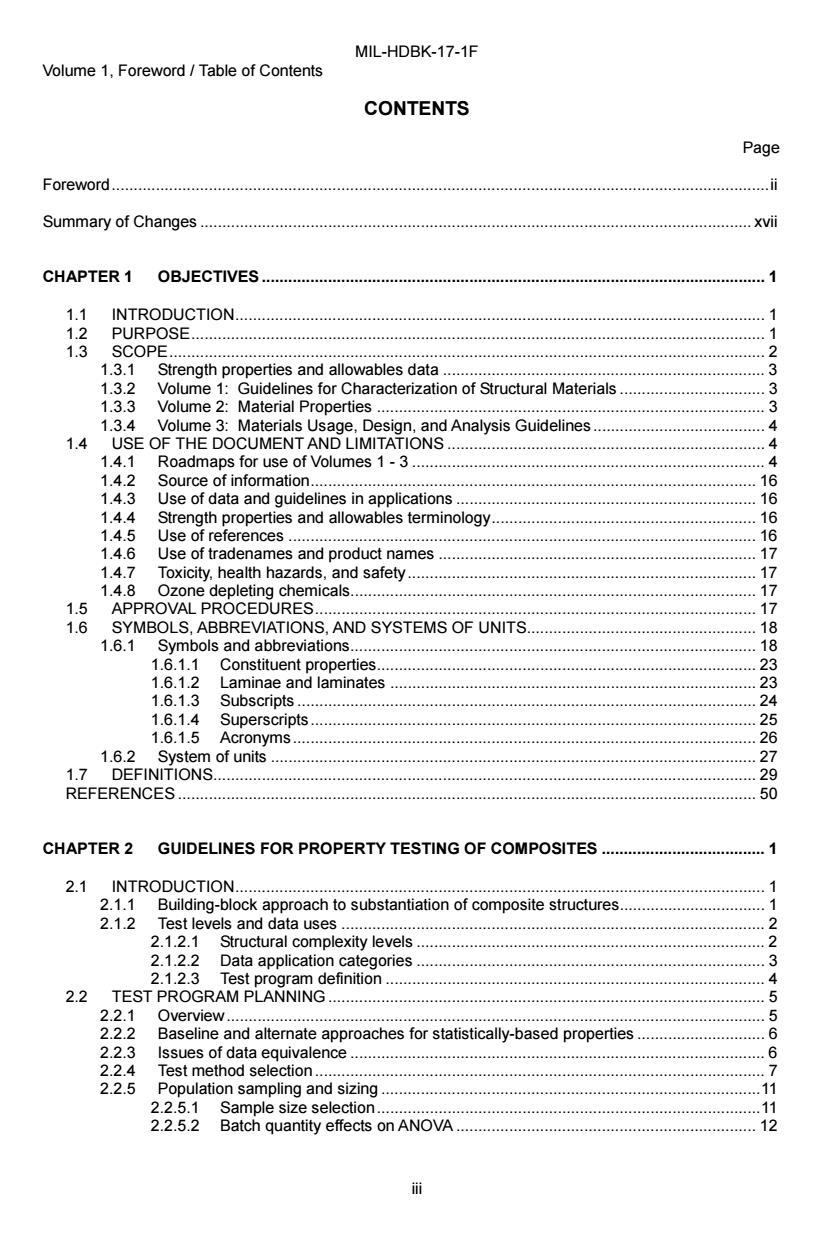
MIL-HDBK-17-1F Volume 1,Foreword Table of Contents CONTENTS Page Foreword. ... Summary of Changes… ......xvii CHAPTER 1 OBJECTIVES.......... 1 1.1 INTRODUCTION… 1.2 PURPOSE 1 .1 1.3 SCOPE .................................................................................... 1.3.1 Strength properties and allowables data....... .3 1.3.2 Volume 1:Guidelines for Characterization of Structural Materials........3 1.3.3 Volume 2:Material Properties........... 03 1.3.4 Volume 3:Materials Usage,Design,and Analysis Guidelines......................................4 1.4 USE OF THE DOCUMENT AND LIMITATIONS...4 1.4.1 Roadmaps for use of Volumes 1-3......4 14.2 Source of information.. 16 1.4.3 Use of data and guidelines in applications.... 16 1.4.4 Strength properties and allowables terminology... 16 1.4.5 Use of references......... 16 1.4.6 Use of tradenames and product names.............. .17 1.4.7 Toxicity,health hazards,and safety. 17 1.4.8 Ozone depleting chemicals................. 17 1.5 APPROVAL PROCEDURES..................... .17 1.6 SYMBOLS,ABBREVIATIONS,AND SYSTEMS OF UNITS. 18 1.6.1 Symbols and abbreviations18 1.6.1.1 Constituent properties.... 23 1.6.1.2 Laminae and laminates...... 23 1.6.1.3 Subscripts.....… 24 1.6.1.4 Superscripts.… 25 1.6.1.5 Acronyms.… .26 1.6.2 System of units.............. 27 1.7 DEFINITIONS... 29 REFERENCES........ ..50 CHAPTER 2 GUIDELINES FOR PROPERTY TESTING OF COMPOSITES.......................... 2.1 INTRODUCTIC0Ni… 2.1.1 Building-block approach to substantiation of composite structures...........................1 2.1.2 Test levels and data uses... 2.1.2.1 Structural complexity levels .......... 2 2.1.2.2 Data application categories..3 2.1.2.3 Test program definition.............. .4 2.2 TEST PROGRAM PLANNING.5 2.2.1 Overview. 2.2.2 5 Baseline and alternate approaches for statistically-based properties.........................6 2.2.3 Issues of data equivalence. 6 2.2.4 Test method selection..... .7 2.2.5 Population sampling and sizing..11 2.2.5.1 Sample size selection...... 2.2.5.2 Batch quantity effects on ANOVA......... .11 .12 讲
MIL-HDBK-17-1F Volume 1, Foreword / Table of Contents iii CONTENTS Page Foreword.....................................................................................................................................................ii Summary of Changes ............................................................................................................................. xvii CHAPTER 1 OBJECTIVES .................................................................................................................. 1 1.1 INTRODUCTION........................................................................................................................ 1 1.2 PURPOSE.................................................................................................................................. 1 1.3 SCOPE....................................................................................................................................... 2 1.3.1 Strength properties and allowables data ......................................................................... 3 1.3.2 Volume 1: Guidelines for Characterization of Structural Materials ................................. 3 1.3.3 Volume 2: Material Properties ........................................................................................ 3 1.3.4 Volume 3: Materials Usage, Design, and Analysis Guidelines....................................... 4 1.4 USE OF THE DOCUMENT AND LIMITATIONS ........................................................................ 4 1.4.1 Roadmaps for use of Volumes 1 - 3 ................................................................................ 4 1.4.2 Source of information..................................................................................................... 16 1.4.3 Use of data and guidelines in applications .................................................................... 16 1.4.4 Strength properties and allowables terminology............................................................ 16 1.4.5 Use of references .......................................................................................................... 16 1.4.6 Use of tradenames and product names ........................................................................ 17 1.4.7 Toxicity, health hazards, and safety............................................................................... 17 1.4.8 Ozone depleting chemicals............................................................................................ 17 1.5 APPROVAL PROCEDURES.................................................................................................... 17 1.6 SYMBOLS, ABBREVIATIONS, AND SYSTEMS OF UNITS.................................................... 18 1.6.1 Symbols and abbreviations............................................................................................ 18 1.6.1.1 Constituent properties...................................................................................... 23 1.6.1.2 Laminae and laminates ................................................................................... 23 1.6.1.3 Subscripts ........................................................................................................ 24 1.6.1.4 Superscripts..................................................................................................... 25 1.6.1.5 Acronyms......................................................................................................... 26 1.6.2 System of units .............................................................................................................. 27 1.7 DEFINITIONS........................................................................................................................... 29 REFERENCES ................................................................................................................................... 50 CHAPTER 2 GUIDELINES FOR PROPERTY TESTING OF COMPOSITES ..................................... 1 2.1 INTRODUCTION........................................................................................................................ 1 2.1.1 Building-block approach to substantiation of composite structures................................. 1 2.1.2 Test levels and data uses ................................................................................................ 2 2.1.2.1 Structural complexity levels ............................................................................... 2 2.1.2.2 Data application categories ............................................................................... 3 2.1.2.3 Test program definition ...................................................................................... 4 2.2 TEST PROGRAM PLANNING ................................................................................................... 5 2.2.1 Overview.......................................................................................................................... 5 2.2.2 Baseline and alternate approaches for statistically-based properties ............................. 6 2.2.3 Issues of data equivalence .............................................................................................. 6 2.2.4 Test method selection ...................................................................................................... 7 2.2.5 Population sampling and sizing ......................................................................................11 2.2.5.1 Sample size selection.......................................................................................11 2.2.5.2 Batch quantity effects on ANOVA .................................................................... 12
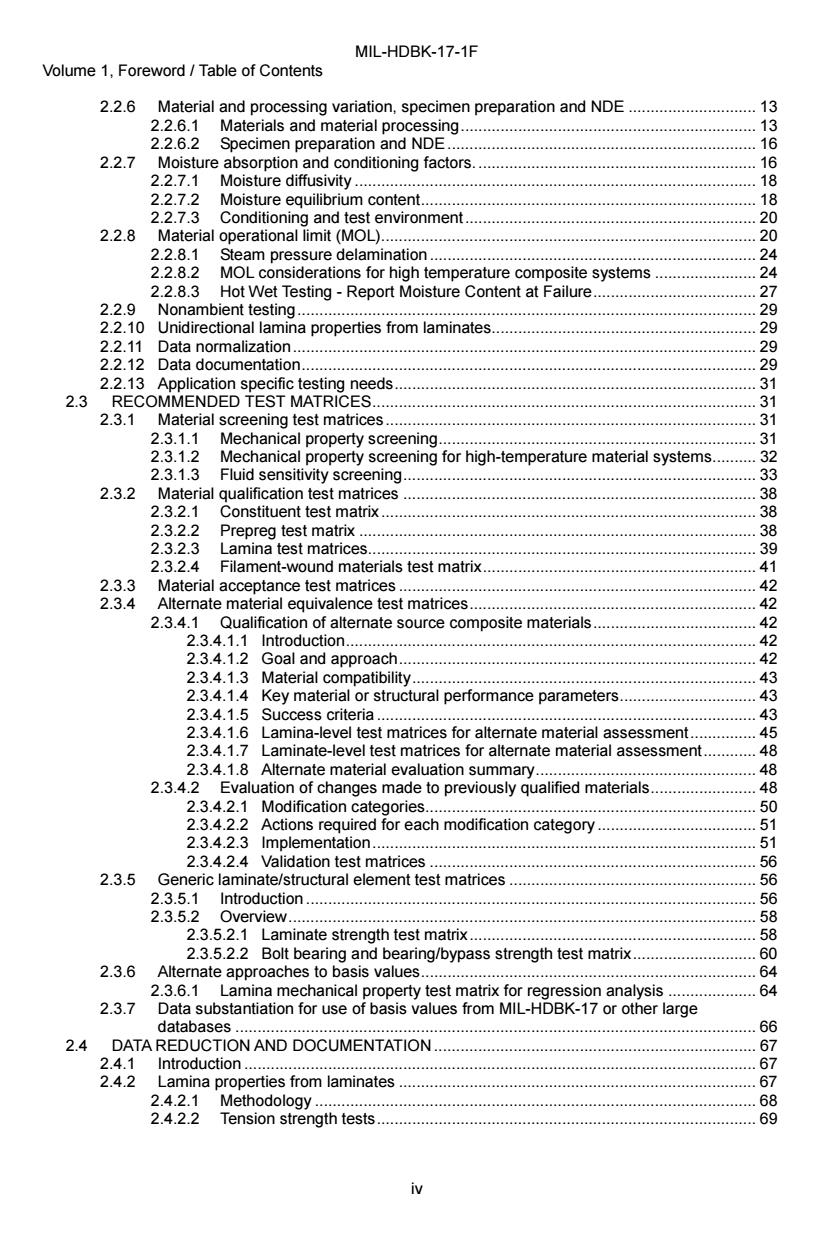
MIL-HDBK-17-1F Volume 1,Foreword Table of Contents 2.2.6 Material and processing variation,specimen preparation and NDE ....13 2.2.6.1 Materials and material processing.. 13 2.2.6.2 Specimen preparation and NDE..... 16 2.2.7 Moisture absorption and conditioning factors......................16 2.2.7.1 Moisture diffusivity 18 2.2.7.2 Moisture equilibrium content..... 18 2.2.7.3 Conditioning and test environment... 20 2.2.8 Material operational limit (MOL). 20 2.2.8.1 Steam pressure delamination.......... 24 2.2.8.2 MOL considerations for high temperature composite systems... 24 2.2.8.3 Hot Wet Testing -Report Moisture Content at Failure................................... 27 2.2.9 Nonambient testing................ 29 2.2.10 Unidirectional lamina properties from laminates.............................................. 29 2.2.11 Data normalization. 29 2.2.12 Data documentation.... 29 2.2.13 Application specific testing needs............... 31 2.3 RECOMMENDED TEST MATRICES...... .31 2.3.1 Material screening test matrices...................... 31 2.3.1.1 Mechanical property screening.............. 31 2.3.1.2 Mechanical property screening for high-temperature material systems..........32 2.3.1.3 Fluid sensitivity screening....33 2.3.2 Material qualification test matrices 38 2.3.2.1 Constituent test matrix. 38 2.3.2.2 Prepreg test matrix.… 38 2.3.2.3 Lamina test matrices.. 39 2.3.2.4 Filament-wound materials test matrix..................... 41 2.3.3 Material acceptance test matrices....... 42 2.3.4 Alternate material equivalence test matrices............. 42 2.3.4.1 Qualification of alternate source composite materials....... 42 2.3.4.1.1 Introduction. 42 2.3.4.1.2 Goal and approach......... 42 2.3.4.1.3 Material compatibility...... 43 2.3.4.1.4 Key material or structural performance parameters...... 43 2.3.4.1.5 Success criteria.................. 43 2.3.4.1.6 Lamina-level test matrices for alternate material assessment............... 5 2.3.4.1.7 Laminate-level test matrices for alternate material assessment............48 2.3.4.1.8 Alternate material evaluation summary...... 48 2.3.4.2 Evaluation of changes made to previously qualified materials.... 48 2.3.4.2.1 Modification categories.......... 50 2.3.4.2.2 Actions required for each modification category......... .51 444 2.3.4.2.3 Implementation...................... 51 2.3.4.2.4 Validation test matrices. 56 2.3.5 Generic laminate/structural element test matrices............................. 56 2.3.5.1 Introduction.. 56 2.3.5.2 Overview....... 58 2.3.5.2.1 Laminate strength test matrix...... 58 2.3.5.2.2 Bolt bearing and bearing/bypass strength test matrix........................... 60 2.3.6 Alternate approaches to basis values............. .64 2.3.6.1 Lamina mechanical property test matrix for regression analysis ................... 64 2.3.7 Data substantiation for use of basis values from MIL-HDBK-17 or other large databaseS..... 66 2.4 DATA REDUCTION AND DOCUMENTATION................... 67 2.4.1 Introduction................. 67 2.4.2 Lamina properties from laminates....... .67 2.4.2.1 Methodology. .68 2.4.2.2 Tension strength tests................... 69 iv
MIL-HDBK-17-1F Volume 1, Foreword / Table of Contents iv 2.2.6 Material and processing variation, specimen preparation and NDE ............................. 13 2.2.6.1 Materials and material processing................................................................... 13 2.2.6.2 Specimen preparation and NDE ...................................................................... 16 2.2.7 Moisture absorption and conditioning factors................................................................ 16 2.2.7.1 Moisture diffusivity ........................................................................................... 18 2.2.7.2 Moisture equilibrium content............................................................................ 18 2.2.7.3 Conditioning and test environment.................................................................. 20 2.2.8 Material operational limit (MOL)..................................................................................... 20 2.2.8.1 Steam pressure delamination .......................................................................... 24 2.2.8.2 MOL considerations for high temperature composite systems ....................... 24 2.2.8.3 Hot Wet Testing - Report Moisture Content at Failure..................................... 27 2.2.9 Nonambient testing........................................................................................................ 29 2.2.10 Unidirectional lamina properties from laminates............................................................ 29 2.2.11 Data normalization......................................................................................................... 29 2.2.12 Data documentation....................................................................................................... 29 2.2.13 Application specific testing needs.................................................................................. 31 2.3 RECOMMENDED TEST MATRICES....................................................................................... 31 2.3.1 Material screening test matrices.................................................................................... 31 2.3.1.1 Mechanical property screening........................................................................ 31 2.3.1.2 Mechanical property screening for high-temperature material systems.......... 32 2.3.1.3 Fluid sensitivity screening................................................................................ 33 2.3.2 Material qualification test matrices ................................................................................ 38 2.3.2.1 Constituent test matrix..................................................................................... 38 2.3.2.2 Prepreg test matrix .......................................................................................... 38 2.3.2.3 Lamina test matrices........................................................................................ 39 2.3.2.4 Filament-wound materials test matrix.............................................................. 41 2.3.3 Material acceptance test matrices ................................................................................. 42 2.3.4 Alternate material equivalence test matrices................................................................. 42 2.3.4.1 Qualification of alternate source composite materials..................................... 42 2.3.4.1.1 Introduction............................................................................................. 42 2.3.4.1.2 Goal and approach................................................................................. 42 2.3.4.1.3 Material compatibility.............................................................................. 43 2.3.4.1.4 Key material or structural performance parameters............................... 43 2.3.4.1.5 Success criteria ...................................................................................... 43 2.3.4.1.6 Lamina-level test matrices for alternate material assessment............... 45 2.3.4.1.7 Laminate-level test matrices for alternate material assessment............ 48 2.3.4.1.8 Alternate material evaluation summary.................................................. 48 2.3.4.2 Evaluation of changes made to previously qualified materials........................ 48 2.3.4.2.1 Modification categories........................................................................... 50 2.3.4.2.2 Actions required for each modification category.................................... 51 2.3.4.2.3 Implementation....................................................................................... 51 2.3.4.2.4 Validation test matrices .......................................................................... 56 2.3.5 Generic laminate/structural element test matrices ........................................................ 56 2.3.5.1 Introduction ...................................................................................................... 56 2.3.5.2 Overview.......................................................................................................... 58 2.3.5.2.1 Laminate strength test matrix................................................................. 58 2.3.5.2.2 Bolt bearing and bearing/bypass strength test matrix............................ 60 2.3.6 Alternate approaches to basis values............................................................................ 64 2.3.6.1 Lamina mechanical property test matrix for regression analysis .................... 64 2.3.7 Data substantiation for use of basis values from MIL-HDBK-17 or other large databases ...................................................................................................................... 66 2.4 DATA REDUCTION AND DOCUMENTATION ......................................................................... 67 2.4.1 Introduction .................................................................................................................... 67 2.4.2 Lamina properties from laminates ................................................................................. 67 2.4.2.1 Methodology .................................................................................................... 68 2.4.2.2 Tension strength tests...................................................................................... 69
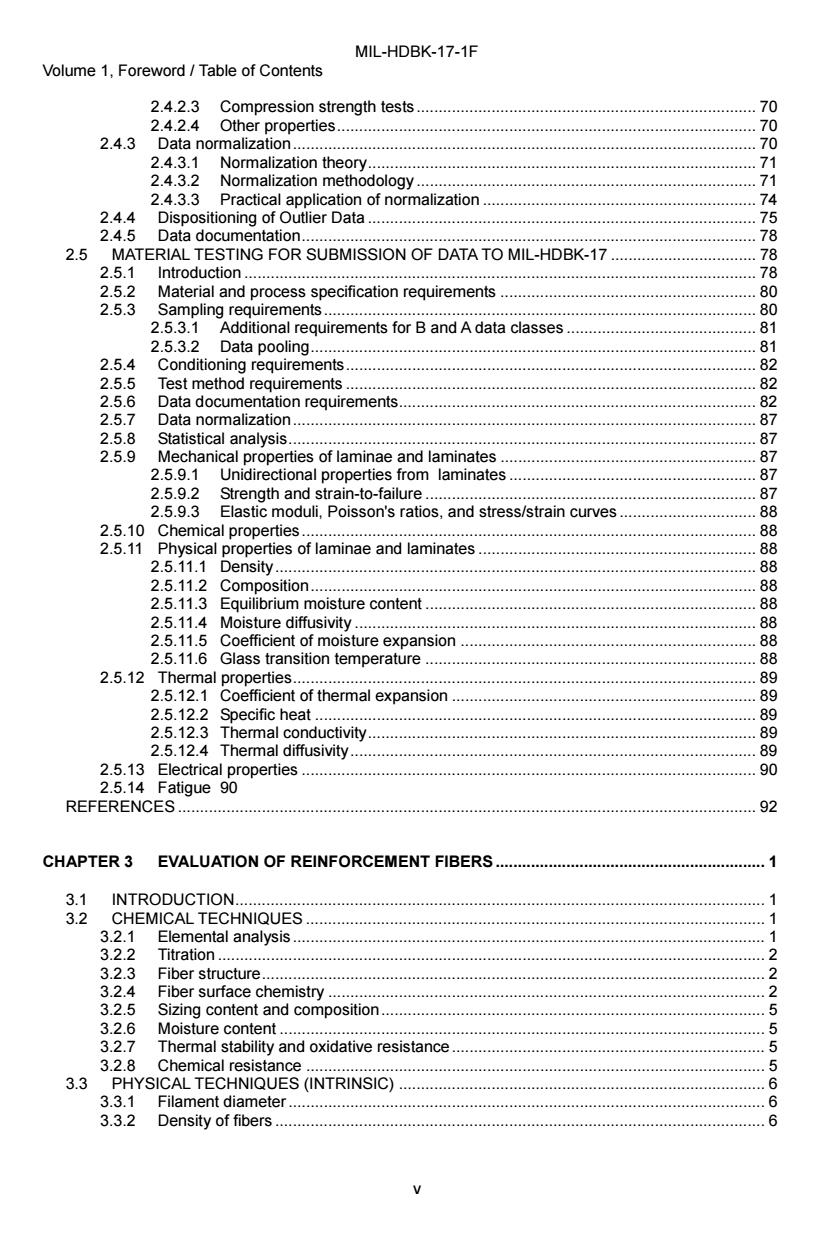
MIL-HDBK-17-1F Volume 1,Foreword Table of Contents 2.4.2.3 Compression strength tests........... 70 2.4.2.4 Other properties... 70 2.4.3 Data normalization.............. 70 2.4.3.1 Normalization theory........................... .71 2.4.3.2 Normalization methodology.71 2.4.3.3 Practical application of normalization............. 74 2.4.4 Dispositioning of Outlier Data... 75 2.4.5 Data documentation.... 78 2.5 MATERIAL TESTING FOR SUBMISSION OF DATA TO MIL-HDBK-17.................................78 2.5.1 Introduction ............ 78 2.5.2 Material and process specification requirements................................. 80 2.5.3 Sampling requirements............... 80 2.5.3.1 Additional requirements for B and A data classes......................................81 2.5.3.2Dat泊p00ling… 81 2.5.4 Conditioning requirements.... 82 2.5.5 Test method requirements........ 44444444444444 82 2.5.6 Data documentation requirements........ ..82 2.5.7 Data normalization..87 2.5.8 Statistical analysis. 7 2.5.9 Mechanical properties of laminae and laminates..................................87 2.5.9.1 Unidirectional properties from laminates............................................87 2.5.9.2 Strength and strain-to-failure...... 87 2.5.9.3 Elastic moduli,Poisson's ratios,and stress/strain curves............................ 88 2.5.10 Chemical properties...... 88 2.5.11 Physical properties of laminae and laminates 88 2.5.11.1 Density...... 88 2.5.11.2C0mp0siti0n......... 88 2.5.11.3 Equilibrium moisture content. 88 2.5.11.4 Moisture diffusivity............... 88 2.5.11.5 Coefficient of moisture expansion ................................... 88 2.5.11.6 Glass transition temperature..... 88 2.5.12 Thermal properties....... 89 2.5.12.1 Coefficient of thermal expansion... 89 2.5.12.2 Specific heat. 89 2.5.12.3 Thermal conductivity 89 2.5.12.4 Thermal diffusivity............... 89 2.5.13 Electrical properties 90 2.5.14 Fatigue 90 REFERENCES. .92 CHAPTER 3 EVALUATION OF REINFORCEMENT FIBERS........1 3.1 INTRODUCTION............ 32CHEMICAL TECHNIQUES 3.2.1 Elemental analysis.......................... .1 3.2.2 Titration... 2 3.2.3 Fiber structure.… 2 3.2.4 Fiber surface chemistry .................... .2 3.2.5 Sizing content and composition...... 5 3.2.6 Moisture content....... 3.2.7 Thermal stability and oxidative resistance....... .5 3.2.8 Chemical resistance 3.3 PHYSICAL TECHNIQUES (INTRINSIC) .6 3.3.1 Filament diameter.... 。。 6 3.3.2 Density of fibers........ .6
MIL-HDBK-17-1F Volume 1, Foreword / Table of Contents v 2.4.2.3 Compression strength tests............................................................................. 70 2.4.2.4 Other properties............................................................................................... 70 2.4.3 Data normalization......................................................................................................... 70 2.4.3.1 Normalization theory........................................................................................ 71 2.4.3.2 Normalization methodology............................................................................. 71 2.4.3.3 Practical application of normalization .............................................................. 74 2.4.4 Dispositioning of Outlier Data ........................................................................................ 75 2.4.5 Data documentation....................................................................................................... 78 2.5 MATERIAL TESTING FOR SUBMISSION OF DATA TO MIL-HDBK-17 ................................. 78 2.5.1 Introduction .................................................................................................................... 78 2.5.2 Material and process specification requirements .......................................................... 80 2.5.3 Sampling requirements.................................................................................................. 80 2.5.3.1 Additional requirements for B and A data classes ........................................... 81 2.5.3.2 Data pooling..................................................................................................... 81 2.5.4 Conditioning requirements............................................................................................. 82 2.5.5 Test method requirements ............................................................................................. 82 2.5.6 Data documentation requirements................................................................................. 82 2.5.7 Data normalization......................................................................................................... 87 2.5.8 Statistical analysis.......................................................................................................... 87 2.5.9 Mechanical properties of laminae and laminates .......................................................... 87 2.5.9.1 Unidirectional properties from laminates ........................................................ 87 2.5.9.2 Strength and strain-to-failure ........................................................................... 87 2.5.9.3 Elastic moduli, Poisson's ratios, and stress/strain curves ............................... 88 2.5.10 Chemical properties....................................................................................................... 88 2.5.11 Physical properties of laminae and laminates ............................................................... 88 2.5.11.1 Density............................................................................................................. 88 2.5.11.2 Composition..................................................................................................... 88 2.5.11.3 Equilibrium moisture content ........................................................................... 88 2.5.11.4 Moisture diffusivity ........................................................................................... 88 2.5.11.5 Coefficient of moisture expansion ................................................................... 88 2.5.11.6 Glass transition temperature ........................................................................... 88 2.5.12 Thermal properties......................................................................................................... 89 2.5.12.1 Coefficient of thermal expansion ..................................................................... 89 2.5.12.2 Specific heat .................................................................................................... 89 2.5.12.3 Thermal conductivity........................................................................................ 89 2.5.12.4 Thermal diffusivity............................................................................................ 89 2.5.13 Electrical properties ....................................................................................................... 90 2.5.14 Fatigue 90 REFERENCES ................................................................................................................................... 92 CHAPTER 3 EVALUATION OF REINFORCEMENT FIBERS ............................................................. 1 3.1 INTRODUCTION........................................................................................................................ 1 3.2 CHEMICAL TECHNIQUES ........................................................................................................ 1 3.2.1 Elemental analysis........................................................................................................... 1 3.2.2 Titration ............................................................................................................................ 2 3.2.3 Fiber structure.................................................................................................................. 2 3.2.4 Fiber surface chemistry ................................................................................................... 2 3.2.5 Sizing content and composition....................................................................................... 5 3.2.6 Moisture content .............................................................................................................. 5 3.2.7 Thermal stability and oxidative resistance....................................................................... 5 3.2.8 Chemical resistance ........................................................................................................ 5 3.3 PHYSICAL TECHNIQUES (INTRINSIC) ................................................................................... 6 3.3.1 Filament diameter ............................................................................................................ 6 3.3.2 Density of fibers ............................................................................................................... 6
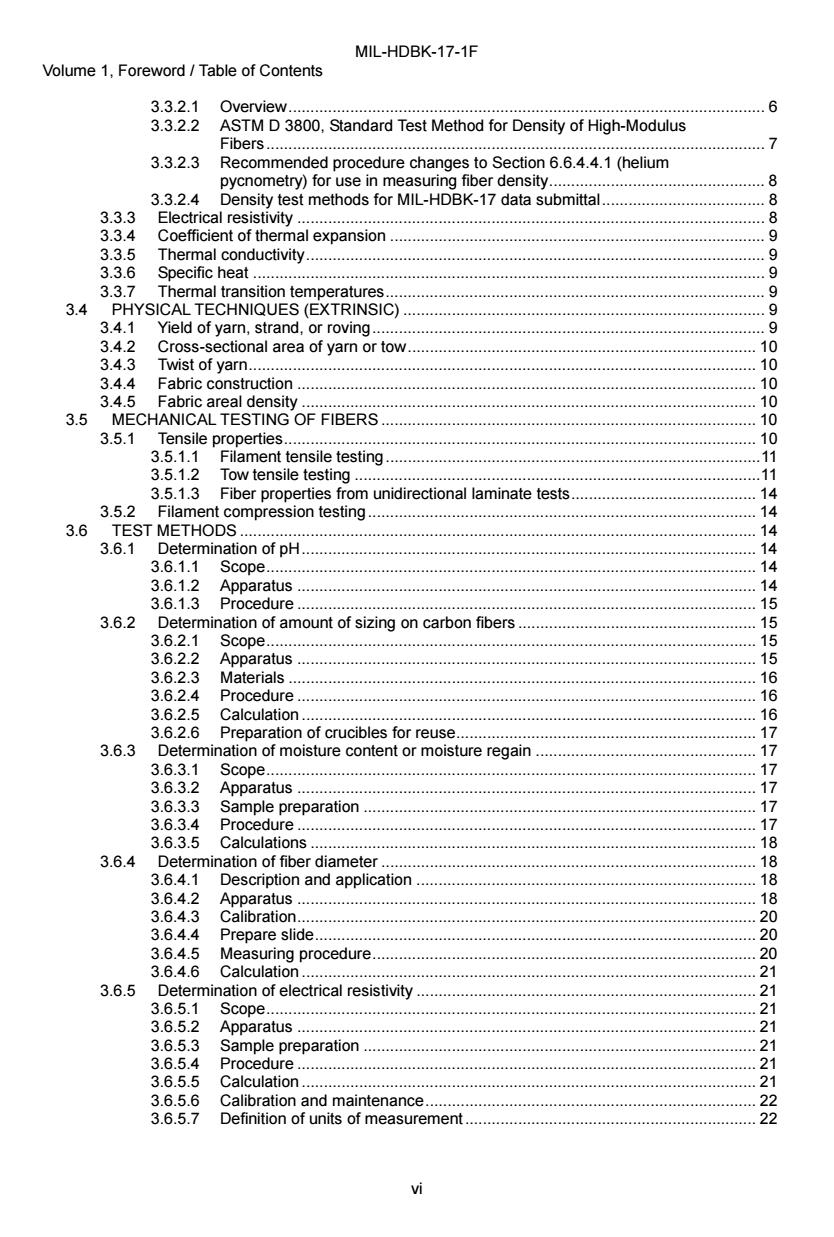
MIL-HDBK-17-1F Volume 1,Foreword Table of Contents 3.3.2.1 Overview.......... ..6 3.3.2.2 ASTM D 3800,Standard Test Method for Density of High-Modulus Fibers........ Recommended procedure changes to Section 6.6.4.4.1(helium 7 3.3.2.3 pycnometry)for use in measuring fiber density...................................8 3.3.2.4 Density test methods for MIL-HDBK-17 data submittal.............. 8 3.3.3 8 Electrical resistivity.. 3.3.4 Coefficient of thermal expansion............. 9 3.3.5 Thermal conductivity... 9 3.3.6 Specific heat.... 9 3.3.7 Thermal transition temperatures........... 9 3.4 PHYSICAL TECHNIQUES (EXTRINSIC).... 9 3.4.1 Yield of yarn,strand,or roving................ .9 3.4.2 Cross-sectional area of yarn or tow.................................................................... 10 3.4.3 Twist of yarn..... 10 3.4.4 Fabric construction.......... 10 3.4.5 Fabric areal density.. 10 3.5 MECHANICAL TESTING OF FIBERS..................... 10 3.5.1 Tensile properties. 10 3.5.1.1 Filament tensile testing....................... 0.11 3.5.1.2 Tow tensile testing… .11 3.5.1.3 Fiber properties from unidirectional laminate tests. 14 3.5.2 Filament compression testing.. 14 3.6 TEST METHODS..... 14 3.6.1 Determination of pH........... 4 3.6.1.1 Scope..... .14 3.6.1.2 Apparatus ....14 3.6.1.3 Procedure.… 15 3.6.2 Determination of amount of sizing on carbon fibers 15 3.6.2.1 SC0pe… 15 3.6.2.2 Apparatus 15 3.6.2.3 Materials 16 3.6.2.4 Procedure... 16 3.6.2.5 Calculation........... 16 3.6.2.6 Preparation of crucibles for reuse. 3.6.3 Determination of moisture content or moisture regain................................................17 3.6.3.1 17 00000600101010000040400000000044000001004014040410000000044400000440040000000000004040000000040 3.6.3.2 Apparatus 1 3.6.3.3 Sample preparation ................ 17 3.6.3.4 Procedure..... 17 44 3.6.3.5 Calculations.… 18 3.6.4 Determination of fiber diameter. 18 3.6.4.1 Description and application....... 18 3.6.4.2 Apparatus 18 3.6.4.3 Calibration.... 20 3.6.4.4 Prepare slide....... 20 3.6.4.5 Measuring procedure.......... 20 3.6.4.6 Calculation....... 21 3.6.5 Determination of electrical resistivity 21 3.6.5.1 SC0pe....... 21 3.6.5.2 Apparatus.… 21 3.6.5.3 Sample preparation.… 21 3.6.5.4 Procedure..… 21 3.6.5.5 Calculation..... 21 3.6.5.6 Calibration and maintenance........ 22 3.6.5.7 Definition of units of measurement... 22 vi
MIL-HDBK-17-1F Volume 1, Foreword / Table of Contents vi 3.3.2.1 Overview............................................................................................................ 6 3.3.2.2 ASTM D 3800, Standard Test Method for Density of High-Modulus Fibers................................................................................................................. 7 3.3.2.3 Recommended procedure changes to Section 6.6.4.4.1 (helium pycnometry) for use in measuring fiber density................................................. 8 3.3.2.4 Density test methods for MIL-HDBK-17 data submittal..................................... 8 3.3.3 Electrical resistivity .......................................................................................................... 8 3.3.4 Coefficient of thermal expansion ..................................................................................... 9 3.3.5 Thermal conductivity........................................................................................................ 9 3.3.6 Specific heat .................................................................................................................... 9 3.3.7 Thermal transition temperatures...................................................................................... 9 3.4 PHYSICAL TECHNIQUES (EXTRINSIC) .................................................................................. 9 3.4.1 Yield of yarn, strand, or roving......................................................................................... 9 3.4.2 Cross-sectional area of yarn or tow............................................................................... 10 3.4.3 Twist of yarn................................................................................................................... 10 3.4.4 Fabric construction ........................................................................................................ 10 3.4.5 Fabric areal density ....................................................................................................... 10 3.5 MECHANICAL TESTING OF FIBERS ..................................................................................... 10 3.5.1 Tensile properties........................................................................................................... 10 3.5.1.1 Filament tensile testing.....................................................................................11 3.5.1.2 Tow tensile testing ............................................................................................11 3.5.1.3 Fiber properties from unidirectional laminate tests.......................................... 14 3.5.2 Filament compression testing........................................................................................ 14 3.6 TEST METHODS ..................................................................................................................... 14 3.6.1 Determination of pH....................................................................................................... 14 3.6.1.1 Scope............................................................................................................... 14 3.6.1.2 Apparatus ........................................................................................................ 14 3.6.1.3 Procedure ........................................................................................................ 15 3.6.2 Determination of amount of sizing on carbon fibers ...................................................... 15 3.6.2.1 Scope............................................................................................................... 15 3.6.2.2 Apparatus ........................................................................................................ 15 3.6.2.3 Materials .......................................................................................................... 16 3.6.2.4 Procedure ........................................................................................................ 16 3.6.2.5 Calculation ....................................................................................................... 16 3.6.2.6 Preparation of crucibles for reuse.................................................................... 17 3.6.3 Determination of moisture content or moisture regain .................................................. 17 3.6.3.1 Scope............................................................................................................... 17 3.6.3.2 Apparatus ........................................................................................................ 17 3.6.3.3 Sample preparation ......................................................................................... 17 3.6.3.4 Procedure ........................................................................................................ 17 3.6.3.5 Calculations ..................................................................................................... 18 3.6.4 Determination of fiber diameter ..................................................................................... 18 3.6.4.1 Description and application ............................................................................. 18 3.6.4.2 Apparatus ........................................................................................................ 18 3.6.4.3 Calibration........................................................................................................ 20 3.6.4.4 Prepare slide.................................................................................................... 20 3.6.4.5 Measuring procedure....................................................................................... 20 3.6.4.6 Calculation ....................................................................................................... 21 3.6.5 Determination of electrical resistivity ............................................................................. 21 3.6.5.1 Scope............................................................................................................... 21 3.6.5.2 Apparatus ........................................................................................................ 21 3.6.5.3 Sample preparation ......................................................................................... 21 3.6.5.4 Procedure ........................................................................................................ 21 3.6.5.5 Calculation ....................................................................................................... 21 3.6.5.6 Calibration and maintenance........................................................................... 22 3.6.5.7 Definition of units of measurement.................................................................. 22
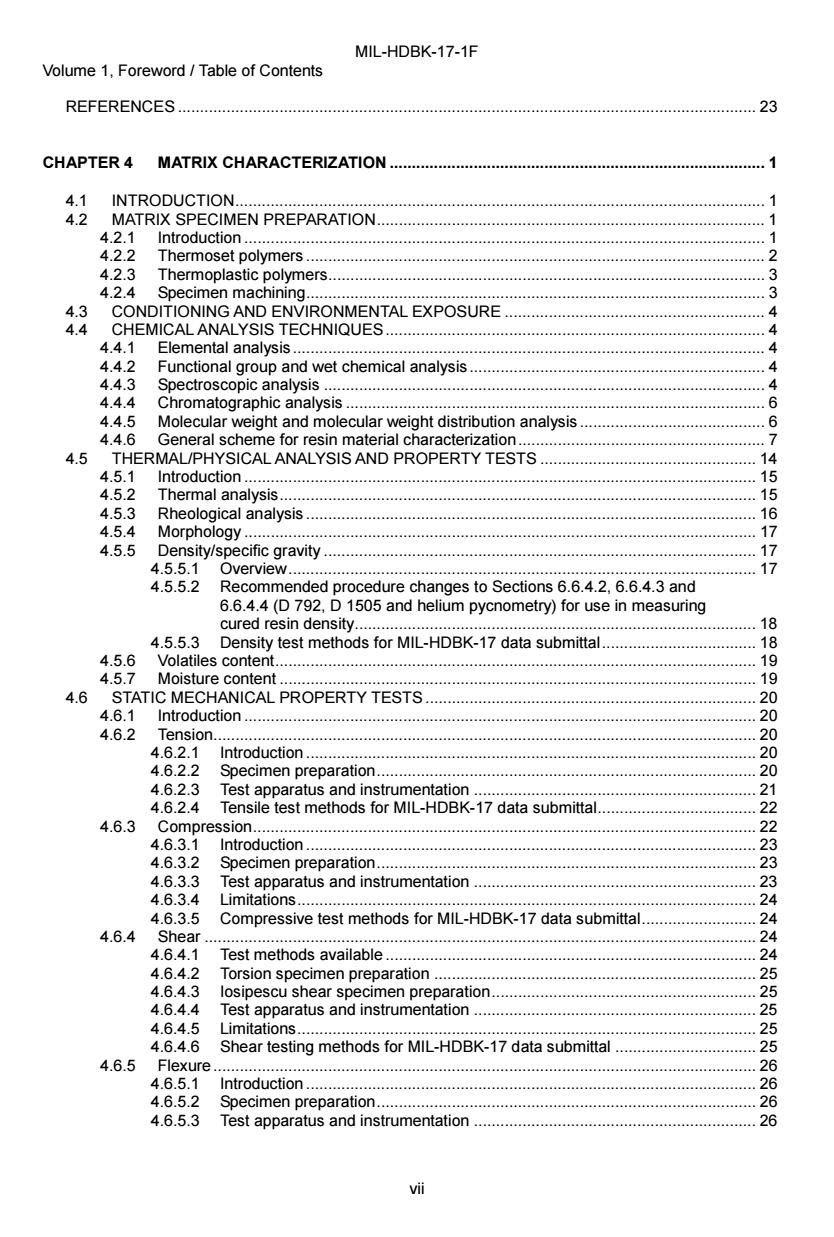
MIL-HDBK-17-1F Volume 1,Foreword Table of Contents REFERENCES 23 CHAPTER 4 MATRIX CHARACTERIZATION.......... 4.1 INTRODUCTION...... 4.2 MATRIX SPECIMEN PREPARATION...................... 1 4.2.1 1 4.2.2 Thermoset polymers................................. . 4.2.3 Thermoplastic polymers..... 3 4.2.4 Specimen machining.... 3 4.3 CONDITIONING AND ENVIRONMENTAL EXPOSURE 4 4.4 CHEMICAL ANALYSIS TECHNIQUES....... 4.4.1 Elemental analysis.......... 4.4.2 Functional group and wet chemical analysis. 4 4.4.3 Spectroscopic analysis... 0.4 4.4.4 Chromatographic analysis................. .6 4.4.5 Molecular weight and molecular weight distribution analysis........ .6 4.4.6 General scheme for resin material characterization... 45 THERMAL/PHYSICAL ANALYSIS AND PROPERTY TESTS 14 4.5.1 Introduction........ 15 4.5.2 Thermal analysis....... 15 4.5.3 Rheological analysis. .16 4.5.4 Morphology. 17 4.5.5 Density/specific gravity... 17 4.5.5.1 Overview.......... 17 4.5.5.2 Recommended procedure changes to Sections 6.6.4.2,6.6.4.3 and 6.6.4.4(D 792,D 1505 and helium pycnometry)for use in measuring cured resin density........... 18 4.5.5.3 Density test methods for MIL-HDBK-17 data submittal............................ 18 4.5.6 Volatiles content 19 4.5.7 Moisture content..... 19 4.6 STATIC MECHANICAL PROPERTY TESTS.............................................. 20 4.6.1 Introduction.. 20 4.6.2 Tension............. 20 4.6.2.1 Introduction..... 20 4.6.2.2 Specimen preparation.. 20 4.6.2.3 Test apparatus and instrumentation 21 4.6.2.4 Tensile test methods for MIL-HDBK-17 data submittal 22 4.6.3 22 4.6.3.1 Introduction...... 23 4.6.3.2 Specimen preparation..... 23 4.6.3.3 Test apparatus and instrumentation.. 23 4.6.3.4 Limitations........................... 24 4.6.3.5 Compressive test methods for MIL-HDBK-17 data submittal.......................... 24 4.6.4 Shear… 24 4.6.4.1 Test methods available. 24 4.6.4.2 Torsion specimen preparation...... 25 4.6.4.3 losipescu shear specimen preparation..................... 25 4.6.4.4 Test apparatus and instrumentation...... 25 4.6.4.5 Limitations........ 25 4.6.4.6 Shear testing methods for MIL-HDBK-17 data submittal .............................. 25 4.6.5 Flexure 26 4.6.5.1 Introduction......... 26 4.6.5.2 Specimen preparation...... 26 4.6.5.3 Test apparatus and instrumentation 26 vii
MIL-HDBK-17-1F Volume 1, Foreword / Table of Contents vii REFERENCES ................................................................................................................................... 23 CHAPTER 4 MATRIX CHARACTERIZATION ..................................................................................... 1 4.1 INTRODUCTION........................................................................................................................ 1 4.2 MATRIX SPECIMEN PREPARATION........................................................................................ 1 4.2.1 Introduction ...................................................................................................................... 1 4.2.2 Thermoset polymers ........................................................................................................ 2 4.2.3 Thermoplastic polymers................................................................................................... 3 4.2.4 Specimen machining........................................................................................................ 3 4.3 CONDITIONING AND ENVIRONMENTAL EXPOSURE ........................................................... 4 4.4 CHEMICAL ANALYSIS TECHNIQUES...................................................................................... 4 4.4.1 Elemental analysis........................................................................................................... 4 4.4.2 Functional group and wet chemical analysis................................................................... 4 4.4.3 Spectroscopic analysis .................................................................................................... 4 4.4.4 Chromatographic analysis ............................................................................................... 6 4.4.5 Molecular weight and molecular weight distribution analysis.......................................... 6 4.4.6 General scheme for resin material characterization........................................................ 7 4.5 THERMAL/PHYSICAL ANALYSIS AND PROPERTY TESTS ................................................. 14 4.5.1 Introduction .................................................................................................................... 15 4.5.2 Thermal analysis............................................................................................................ 15 4.5.3 Rheological analysis ...................................................................................................... 16 4.5.4 Morphology .................................................................................................................... 17 4.5.5 Density/specific gravity .................................................................................................. 17 4.5.5.1 Overview.......................................................................................................... 17 4.5.5.2 Recommended procedure changes to Sections 6.6.4.2, 6.6.4.3 and 6.6.4.4 (D 792, D 1505 and helium pycnometry) for use in measuring cured resin density........................................................................................... 18 4.5.5.3 Density test methods for MIL-HDBK-17 data submittal................................... 18 4.5.6 Volatiles content............................................................................................................. 19 4.5.7 Moisture content ............................................................................................................ 19 4.6 STATIC MECHANICAL PROPERTY TESTS ........................................................................... 20 4.6.1 Introduction .................................................................................................................... 20 4.6.2 Tension........................................................................................................................... 20 4.6.2.1 Introduction ...................................................................................................... 20 4.6.2.2 Specimen preparation...................................................................................... 20 4.6.2.3 Test apparatus and instrumentation ................................................................ 21 4.6.2.4 Tensile test methods for MIL-HDBK-17 data submittal.................................... 22 4.6.3 Compression.................................................................................................................. 22 4.6.3.1 Introduction ...................................................................................................... 23 4.6.3.2 Specimen preparation...................................................................................... 23 4.6.3.3 Test apparatus and instrumentation ................................................................ 23 4.6.3.4 Limitations........................................................................................................ 24 4.6.3.5 Compressive test methods for MIL-HDBK-17 data submittal.......................... 24 4.6.4 Shear ............................................................................................................................. 24 4.6.4.1 Test methods available .................................................................................... 24 4.6.4.2 Torsion specimen preparation ......................................................................... 25 4.6.4.3 Iosipescu shear specimen preparation............................................................ 25 4.6.4.4 Test apparatus and instrumentation ................................................................ 25 4.6.4.5 Limitations........................................................................................................ 25 4.6.4.6 Shear testing methods for MIL-HDBK-17 data submittal ................................ 25 4.6.5 Flexure........................................................................................................................... 26 4.6.5.1 Introduction ...................................................................................................... 26 4.6.5.2 Specimen preparation...................................................................................... 26 4.6.5.3 Test apparatus and instrumentation ................................................................ 26